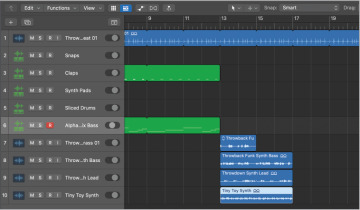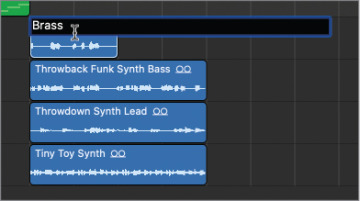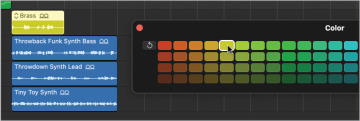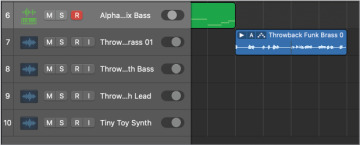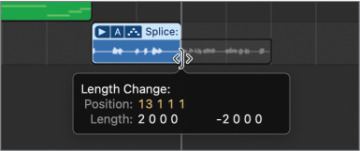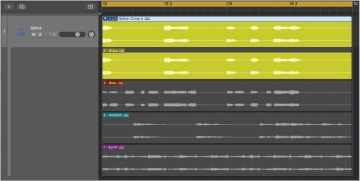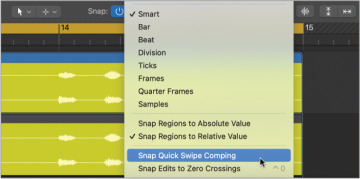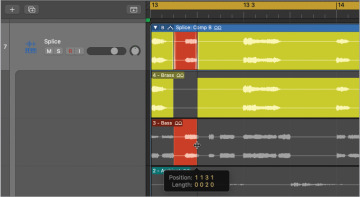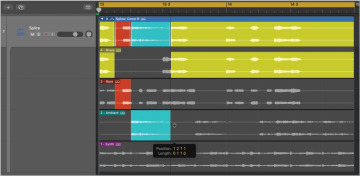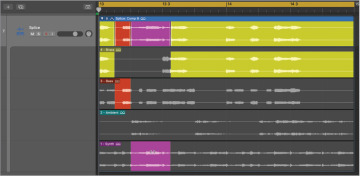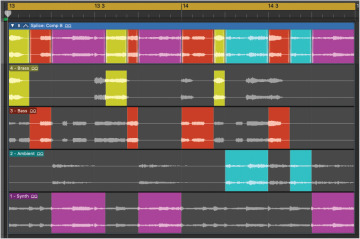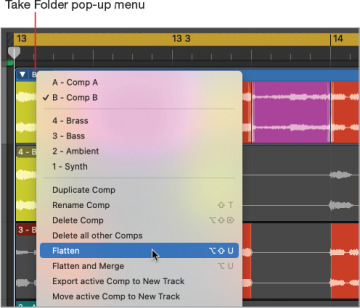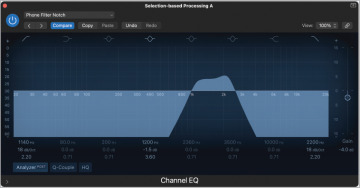- Sampling Single Notes
- Sampling and Slicing Drums
- Transposing a Sample While Keeping It Synced to the Project Tempo
- Chopping Loops in a Take Folder
- Creating Vocal Chops
- Key Commands
Chopping Loops in a Take Folder
While a sampler can often greatly speed up your workflow, you can do sampling work without one. To cut up your samples, mangle them by processing them through effects, and splice them, you are free to use any other tool at your disposal. One of the most obvious and immediate techniques is to drag your samples directly to the Tracks view, and then edit the regions to cut and process your samples.
Packing Regions into a Take Folder
In the previous lesson, you recorded several takes of a guitar performance packed into a take folder. That lets you experiment with different ideas during the recording session, and then later assemble a composite take by choosing sections from multiple takes—a process called comping.
Comping techniques can be useful, for example, when a musician can’t get an entire song right in one single take. You record several takes, each with its own good and bad qualities, and later you create a perfect comp using the best parts of each take.
In this exercise, you’ll use a take folder for a more creative music production goal. You’ll pack four loops of various instruments playing different melodies, and then create a comp by selecting slices from the different loops to combine them into a patchwork loop—like a rhythmic collage of bits and pieces that each have a different timbre.
In the Loop Browser, search for the following loops and drag them to create new tracks at the bottom of the workspace at bar 13.
Throwback Funk Brass 01
Throwback Funk Synth Bass
Throwdown Synth Lead
Tiny Toy Synth
To help identify the loops, let’s give them different colors and simple names.
Click the Throwback Funk Brass 01 region to select it.
Press Shift-N and enter Brass.
Choose View > Show Colors (or press Option-C).
The Color palette opens.
Click a yellow color square.
The Brass region is yellow.
Repeat this process to rename and color the remaining three loops in the take folder.
Rename Throwback Funk Synth Bass Bass, and color it brown.
Rename Throwdown Synth Lead Ambient, and color it turquoise.
Rename Tiny Toy Synth Synth, and color it pink.
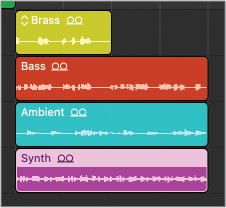
Choose View > Hide Colors (or press Option-C) to close the Color palette.
Select the four regions at bar 13.
In the Tracks view menu bar, choose Functions > Folder > Pack Take Folder.
The four loops are packed inside a take folder on the selected track, leaving you with three empty tracks that you can delete.
Choose Track > Delete Unused Tracks (or press Shift-Command-Delete).
The empty tracks are deleted. Let’s rename the track where the take folder is.
On the Throwback Funk Brass 01 track header, double-click the track name and enter Splice.
The take folder is selected, and you can name it after the track name.
Choose Functions > Name Regions/Cells by Track Name (or press Option-Shift-N).
Control-click the icon on the Splice track, and choose the desired icon.
Resize the take folder to shorten it to two bars long.
Double-click the take folder to open it.
Choose Navigate > Set Rounded Locators by Selection and Enable Cycle (or press U).
To zoom in on the selection, you can press Z (Toggle Zoom to Fit Selection or All Contents).
Press Z.
The take folder fills the workspace, making it comfortable for you to see the waveforms on each take.
You’ve imported four Apple Loops into your workspace and packed them into a take folder. A little organization goes a long way, and taking the time to give your region simple descriptive names and easy-to-identify colors, and optimizing your zoom level sets you up nicely for the next exercise, where you’ll assemble your composite take.
Comping Takes
Before you start comping, you need to preview the takes so that you can become familiar with them. Then you’ll start comping the takes, swiping your mouse across the parts of the takes you want to hear in your comp. To create a rhythmic effect synced to the project tempo, you’ll snap your edits to the nearest 1/16 note.
In the Tracks view menu bar, click the Snap pop-up menu, and choose Snap Quick Swipe Comping.
Click the Snap pop-up menu again, and choose Division.
By default, the division is a 1/16 note, so swiping takes will snap to the nearest 1/16 note on the grid.
Option-click the Brass take to select it.
On the Bass take, drag to select from 13 1 3 0 to 13 2 0 0 so that the help tag reads Position 1 1 3 1, Length 0 0 2 0.
The pointer snaps to a 1/16 note grid, making it easy for you to select a section that has musical meaning (for example, a 1/16 note, an 1/8 note, or a beat).
Listen to your comp.
The comp starts with a brass note, and then the following syncopated note is from the distorted bass synth loop.
On the Ambient take, select the note right after the bass slice so that the help tag reads Position 1 2 1 1, Length 0 1 1 0.
The comp now plays successive notes from the brass, then the distorted bass synth, then the ambient synth. The rapid rhythmic timbre switching creates an exhilarating sensation that is sure to make people get up and dance!
When you select a section, you can hear that section in different takes.
Try clicking different takes in the same section as that last note.
A different take is selected only for that section. This gives you an easy way to experiment with selecting the same section in different takes.
Within that section, click the Ambient take again.
Continue making selections of single or multiple notes (or even portions of notes) from different takes throughout the rest of the take folder.
Feel free to have fun and experiment to find what sounds good to you; then, for the next exercise try to reproduce the comp on the previous screenshot as close as possible.
You’ve comped the four loops into an exciting 1/16 note–based rhythmic collage. Keep this technique in mind and be creative with your use of material. For example, think of comping vocal regions to create a vocal chop, or drum regions to create a breakbeat.
Processing a Selection with Audio Effect Plug-ins
When you are happy with your comp, you can flatten it to export all the selections as individual audio regions on the track so that you can further edit or process them. You’ll now flatten the take folder you comped in the previous exercise so that you can use the Region inspector to transpose individual notes and apply selection-based processing to process individual sections with audio effect plug-ins.
At the upper left of the take folder, click the Take Folder pop-up menu, and choose Flatten.
Each section of the comp is now an individual region of the color of the original take. All regions have the same name (Splice: Comp A). Let’s give the regions individual names. When multiple regions are selected, giving one of them a name that ends with a number results in the regions getting the same name but with incremental numbers.
Press Shift-N.
A text field opens on top of the first region.
Enter Slice 1.
The regions are named Slice with incremental numbers. Let’s transpose the Slice 3 region (the turquoise region that contains a note from the Ambient loop).
Click the background in the workspace to deselect all regions (or press Shift-D).
Click the Slice 3 region to select it.
In the Region inspector, click the double-arrow symbol next to Transpose, and choose –12.
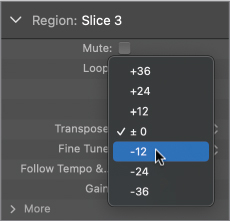
Use the Space bar to start and stop playback when you need to hear your work. The Slice 3 region now plays one octave lower. Continue transposing some of the regions to +12 or –12 semitones so that they play an octave higher or lower. Feel free to experiment with other values; however, in that case, make sure the transposition amounts you choose maintain all the notes in the right key or the loop may sound out of key with the other sections in the project.
You’ll now apply an effect plug-in to only one region using selection-based processing. To make it easier for you to hear the result of your processing, you may want to start with one of your longer regions. If you reproduced the same comp as in the screenshot in the previous exercise, you’ll apply the effect to the Slice 7 region.
Select the Slice 7 region (or one of your longer regions) on the Splice track.
In the Tracks view menu bar, choose Functions > Selection-Based Processing (or press Shift-Option-P).
The Selection-Based Processing window lets you choose between two sets of plug-ins (A or B) so that you can experiment with and compare two audio processing signal chains. You’ll use only one plug-in, so let’s insert it in set A.
Click an empty slot in set A, and choose EQ > Channel EQ.
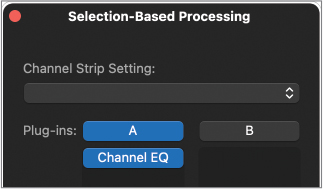
The Channel EQ plug-in window opens.
In the Channel EQ plug-in header, click the Setting pop-up menu, and choose 07 EQ Tools > Phone Filter Notch.
This severe EQ preset filters most of the low and high frequencies, letting through only a narrow band of midrange frequency, reminiscent of the low-fidelity sound of older phones. Before you preview the result, you’ll make sure the preview function does not affect your current cycle area so that you can preview the effect of the EQ plug-in in the context of the entire loop.
At the lower left of the Selection-Based Processing window, click the action menu and deselect “Preview enables Cycle.”
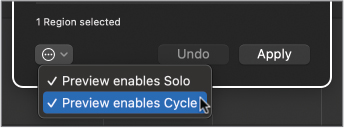
Click the Preview button.
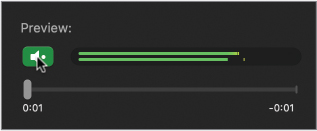
Playback starts at the beginning of the cycle area at bar 13, and you can hear the EQ’ed Slice 7 region in the context of the entire section. The EQ cuts off so many frequencies that the processed region sounds too soft now.
Click the Preview button to stop playback.
In the Selection-Based Processing window, click the Gain pop-up menu, and choose Loudness Compensation.
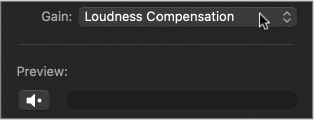
The loudness compensation will be processed only after you apply the effect.
At the lower right of the Selection-Based Processing window, click Apply.
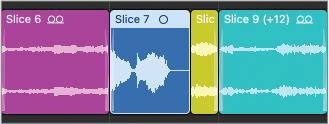
In the workspace, the selected region is processed by the Phone Filter Notch Channel EQ preset. The new region is automatically assigned the color of the track (blue).
Press the Space bar.
The processed region now sounds loud enough. All the different timbres in the samples combined together create a fun, syncopated new loop!
Close the Selection-Based Processing and Channel EQ plug-in windows.
Click the cycle area (or press C) to turn off Cycle mode.
You flattened your take folder to export the selected portions of your takes into individual regions in the workspace. You then transposed some of the regions in the Region inspector and processed one region with a plug-in, completing your patchwork sample collage.
